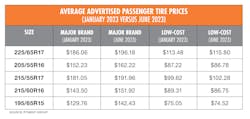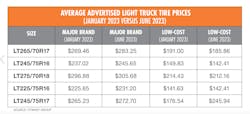Tire Pricing finally appears to be stabilizing. But long-term normalization of tire prices - at both sell-in and sellout - remains dependent on a wide range of factors, according to JP Brooks, director of business development for Duluth, Minn. - based Fitment Group, which analyzes millions of passenger and light truck tire prices weekly.
"We continue to see prices increase slightly on most consumer goods, as well as tires, but the trajectory has slowed significantly," says Brooks, who provides FItment Group's take on consumer tire pricing at mid-year in this MTD exclusive.
MTD: Earlier this year, you mentioned inflation levels were moderating and could work in favor of tire dealers. Has that occurred? What impact has this had on dealers?
Brooks: Before we dive into retail tire pricing, I think it's important to first look at the state of overall inflation in the U.S. On May 10, the U.S. Bureau of Labor Statistics released its latest inflation data through April. A lot of data was dumped upon us, but in short, consumer prices are still rising. However, the rate of increase has slowed substantially. The Consumer Price Index (CPI) rose 4.9% in April from a year earlier. At its peak, the CPI was just above 9% last summer, so the good news is that inflation seems to be taming and what the Fed is doing as far as raising interest rates seems to be working.
What effects has that had on tire retailers? With the significant price increases we saw in 2022, many tire retailers reported the trend of consumers trading down a tier or two as the prices of tier-one tires were hard to absorb for a lot of consumers, (especially) with the other consumer goods price increases they were experiencing.
Over the last five months, we've seen retail sellout data decline by single digits, with inflation pressure being a key component. Consumers are slowing down on some of their spending. I anticipate we will likely see a continued flight to value, where consumers are trading down a tier or two, and a soft sellout market while the overall market starts to stabilize.
MTD: Will we see a moderation in inflation during the second half of the year?
Brooks: We've seen tire prices following relatively the same trend line that's following inflation, so as long as we continue to see those inflation numbers stabilize and slightly increase, I believe we are going to see the same thing with retail prices.
MTD: Near the end of 2022, advertised pricing on major brand tires seemed to decline. Will that trend continue?
Brooks: I would say 'decline' wouldn't be the best word. It's been more of a stabilization. We continue to see prices increase slightly on most consumer goods, as well as tires, but the trajectory has slowed significantly. There are some outliers, but when we look at the advertised tire pricing today, it closely tracks with the CPI and core inflation. The Fed targets a 2% inflation rate, which is an increase, so prices are going to go up. But the target rate of 2% overall is considered low enough for consumers to absorb. We're not quite there yet with tire prices.
Inflation is trending down, but we're not at the Fed target of 2%, so we're not considered stabilized. It's really kind of how you view it. If consumer prices go up 2% year to year, the Fed is OK with that because that's a comfortable increase for consumers to absorb. If tire prices are going up slightly, that is not a cause for alarm - as long as they are not going up significantly and/or tracking outside the standard rate of inflation. If the CPI is at 4.9% and tires are at an 8% increase, then something is out of whack. Now we have an outlier.
MTD: We've seen drastically fewer price hikes announced by tiremakers this year versus the past two years. Why is that and has the window for tire manufacturer price increases closed?
Brooks: We still have a lot of economic uncertainty, but I don't believe we'll see anything close to the increase we saw in 2022. Raw material costs are moderating, the supply chain has moderated and consumers, at the end of the day, can't really absorb more increases across all consumer goods - not just tires. With sellout decreasing, as well, it's a pretty bad time to raise prices again.
MTD: What can MTD readers expect to see regarding tire pricing during the rest of 2023 and why?
Brooks: There's still a lot of economic uncertainty to wade through. We still have a war in Eastern Europe. We have tensions with China. And we still might have more interest hike rates on the horizon. However, we look to be moving in the right direction with inflation. And on top of that, the average age of cars and light trucks in the U.S. has risen again this year, so now the average age of vehicles in the U.S. is 12.5 years. That means more people are keeping their vehicles and repairing them.
I feel that as we continue to see a leveling of tire prices, we will continue to see a continued flight to value during 2023. As inflation continues to moderate and tire prices moderate along with inflation, we might see an uptick in tier-one tire (sales) at the end of the year as consumers feel not quite burdened by higher consumer prices. With fewer people buying new vehicles, they may feel less burdened financially and will want to make an investment in new tires. We'll have to wait and see what the data looks like in six months.
About the Author
Mike Manges
Editor
Mike Manges is Modern Tire Dealer’s editor. A 28-year tire industry veteran, he is a three-time International Automotive Media Association Award winner, holds a Gold Award from the Association of Automotive Publication Editors and was named a finalist for the prestigious Jesse H. Neal Award, the Pulitzer Prize of business-to-business media, in 2024. He also was named Endeavor Business Media's Editor of the Year in 2024. Mike has traveled the world in pursuit of stories that will help independent tire dealers move their businesses forward. Before rejoining MTD in 2019, he held corporate communications positions at two Fortune 500 companies and served as MTD’s senior editor from 2000 to 2010.


